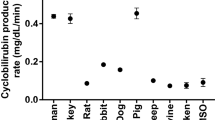Summary
Kubelka-Munk theory of radiation transfer in turbid media is applied to determine the influence of skin optical losses on the efficiency of phototherapy of neonatal hyperbilirubinemia. By using a multilayer model of the skin and a rate equation analysis of bilirubin photo-isomerization, the photon absorption rates of birilubin and of its configurational photoisomers and, in turn, the photoequilibrium concentrations and rise time are calculated for spectrally Gaussian light sources and fluorescent lamps used in phototherapy. It turns out that light absorption and scattering processes in the skin layers produce a 30 nm red-shift of the optimum value of the peak excitation wave-length of bilirubin absorption and photoequilibrium rise time. The comparative data on the phototherapeutical efficiency of different spectral regionsin vivo (Gunn rats and humans) are discussed.
Riassunto
L'influenza delle perdite ottiche cutanee sul rendimento della fototerapia dell'iperblirubinemia neonatale è investigata mediante l'impiego della teoria di Kubelka-Munk sulla propagazione della luce in mezzi torbidi. L'evoluzione temporale delle concentrazioni di bilirubina e dei suoi fotoisomeri configurazionali è studiata per mezzo delle equazioni di bilancio nel caso del modello a multistrati della cute, assumendo una sorgente con distribuzione spettrale gaussiana e i profili spettrali delle principali lampade fluorescenti usate clinicamente. I risultati indicano che l'assorbimento e la diffusione della luce negli strati cutanei sposta di circa 30 nm verso lunghezze d'onda maggiori il valore ottimale della lunghezza d'onda d'assorbimento della bilirubina e del tempo di fotoequilibrio. Si discutono comparativamente i dati sul rendimento foroterapeutico di diverse regioni spettraliin vivo (su ratti Gunn e uomo).
Резюме
Теория Кубелки-Мунка рационального переноса в мутной среде применяется для определения влияния оптических потерь в поверхностном слое на эффективность фототерапии. Используя многослойную модель кожи и анализ фотоизомеризации билирубина, вычисляются интенсивности поглощения фототонов билирубином и его конфигурационным фотоизомерами и, в свою очередь, фоторавновесные концентрации и времена возникновения для источников света с гауссовым спектром и для флуоресцентных ламп, используемых в фототерапии. Оказывается, что процессы поглощения и рассеяния света в поверхностных слоях кожи приводят к красному смещению 30 нм оптимальной величины длины волны для поглощения билирубином. Обсуждаются сравнительные данные об эффективности фототерапии в различных спектральных областях «в естественных условиях».
Similar content being viewed by others
Literatur
J. F. Ennever, A. F. McDonagh andW. T. Speck:Phototherapy for neonatal jaundice: optimal wavelength of light, inJ. Pediatr.,102, 295 (1983).
R. R. Anderson andJ. A. Parrish:The optics of human skin, inJ. J. Invest. Dermatol.,77, 13 (1981).
A. A. Lamola, J. Flores andF. H. Doleiden:Quantum yield and equilibrium position of the configurational photoisomerization of bilirubin bound to human serum albumin, inPhotochem. Photobiol.,35, 649 (1982).
R. Pratesi, G. Agati andF. Fusi:Configurational photoisomerization of bilirubin. I. Quenching of Z → E isomerization witht wo-wavelength irradiation, to be published inPhotochem. Photobiol.
A. F. McDonagh:Molecular mechanism of phototherapy of neonatal jaundice, inNew Trends in Phototherapy, edited byF. Rubaltelli andG. Jori (Plenum Press, New York, N.Y., 1984).
S. Wan, R. R. Anderson andJ. A. Parrish:Analytical modeling for the optical properties of the skin with «in vitro» and «in vivo» applications, inPhotochem. Photobiol.,34, 493 (1981).
A. A. Lamola: personal communication.
J. F. Ennever andW. T. Speck:Mechanism of action of phototherapy: new aspects inNew Trends in Phototherapy, edited byF. Rubaltelli andG. Jori (Plenum Press, New York, N.Y., 1984).
G. Agati, F. Fusi andR. Pratesi:Configurational photoisomerization of bilirubin. II: Comparison of laser and fluorescent lamp excitation (to be published).
A. F. McDonagh andL. M. Ramonas:Jaundice phototherapy: microflow cell photometry reveals rapid biliary response of gunn rats to lights, inScience,201, 829 (1978).
L. Ballowitz, G. Gentler, J. Krochmann, R. Pannitschka, G. Roemer andI. Roemer:Phototherapy in gunn rats, inBiol. Neonate,31, 229 (1977).
R. Hewitt, R. M. Klein andJ. F. Lucey:Photodegradation of serum bilirubin in the gunn rat, inBiol. Neonate,21, 112 (1972).
G. R. Gutcher, W. M. Yen andG. B. Odell:The «in vitro» and «in vivo» photo-reactivity of bilirubin. I. Laser-defined wavelength dependence, inPediatr. Res.,17, 120 (1983).
C. Vecchi, G. P. Donzelli, M. G. Migliorini, G. Sbrana andR. Pratesi:New light in phototherapy, inThe Lancet,1, 390 (1982).
G. P. Donzelli, M. G. Migliorini, R. Pratesi, G. Sbrana andC. Vecchi:Laseroriented search of optimum light for phototherapy, inNew Trends in Phototherapy, edited byF. Rubaltelli andG. Jori (Plenum Press, New York, N.Y., 1984).
A. A. Lamola, W. E. Blumberg, R. Mc Clead andA. Fanaroff:Photoisomerized bilirubin in blood from infants receiving phototherapy, inProc. Natl. Acad. Sci. USA,78, 1882 (1981).
R. Pratesi:Two-lights for phototherapy, inThe Lancet,1, 859 (1983).
B. S. Rosenstein andJ. M. Ducore:Induction of DNAstrand breaks in normal human fibroblasts in the 240–546 nm range, inPhotochem. Photobiol.,38, 51 (1983).
Author information
Authors and Affiliations
Rights and permissions
About this article
Cite this article
Pratesi, R., Agati, G., Cecchi, G. et al. Influence of skin optical losses on configurational photoisomerization of bilirubin during phototherapy. Il Nuovo Cimento D 3, 1075–1095 (1984). https://doi.org/10.1007/BF02478074
Received:
Issue Date:
DOI: https://doi.org/10.1007/BF02478074



